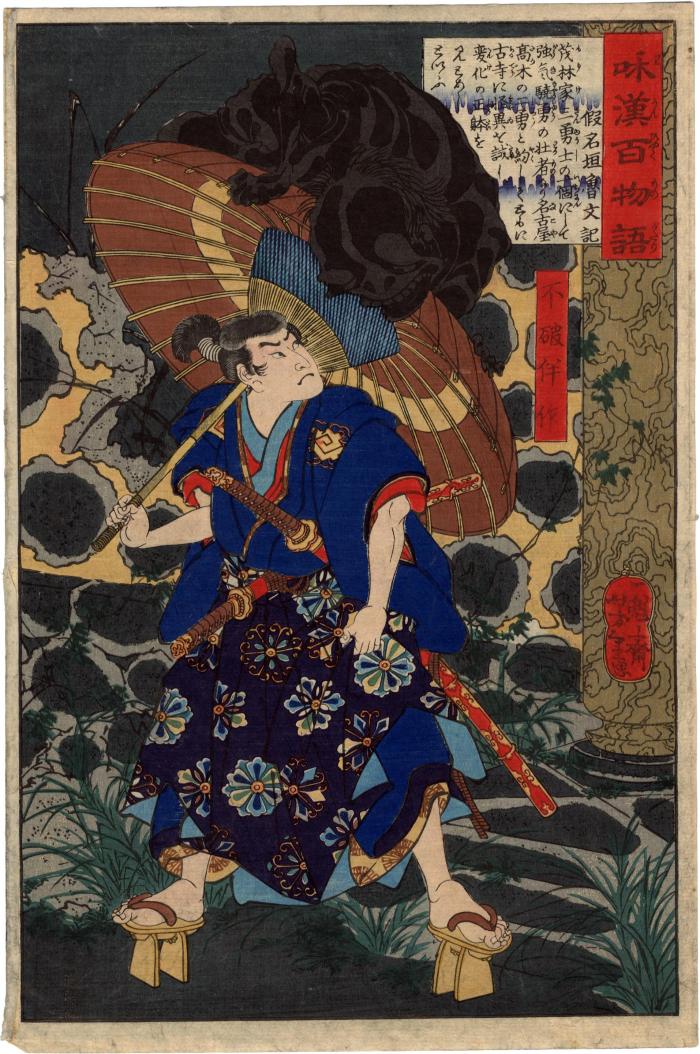Tsukioka Yoshitoshi (月岡芳年) (artist 04/30/1839 – 06/09/1892)
Fuwa Bansaku (不破伴作): Wakan Hyaku Monogatari (和漢百物語) from the series 100 Ghost Stories From China and Japan
08/1865
9.5 in x 14.25 in (Overall dimensions) Japanese woodblock print
Signed: Ikkaisai Yoshitoshi ga
一魁斎芳年画
Hagi Uragami Museum of Art
Los Angeles County Museum of Art
Museum of Fine Arts, Boston
Waseda University
Rijksmuseum
Minneapolis Institute of Art
Spencer Museum of Art The text in the upper right is by Kanagaki Robun (假名垣魯文). It says:
"He was one of a trio of brave samurai of the Mori family, a young man of fierce spirit, strength and courage. With the other two heroes, Naboya and Takaki, he set out to examine mysterious ghosts at an old temple and unmasked the true character of these grotesques."
Fuwa Bansaku was the handsome page and favorite of Toyotomi Hidetsugu (1568-1595). Hidetsugu was Hideyoshi's adopted son; his perverse eccentricities (such as using passers-by for target practice and cutting open pregnant women) eventually led to a non-refusable request for his suicide. Nagoya Sanzaburō was a young retainer of Gamō Ujisato, one of Hideyoshi's generals, who tried to restrain Hidetsugu's excesses. Bansaku's rivalry with Nagoya features in the plots of several Kabuki plays.
Against a background of a broken temple wall of rocks and plaster, the young Bansaku wears a costume typical of a nimaime, a Kabuki term meaning handsome hero, including high geta and fine swords. He holds a fashionable janome, snake-eye umbrella on which is perched a grinning black monster. Bansaku is undeterred. Perhaps the apparition is weightless. Wild grasses pierce the wall and flagstones of the ruined temple."
Quoted from: Yoshitoshi's Strange Tales by John Stevenson, p. 44.
****
Illustrated:
1) In color in Yoshitoshi: Masterpieces from the Ed Fries Collection by Chris Uhlenbeck and Amy Reigle Newland, et al., Hotei Publishing, 2011, p. 80. In the text it is noted that Bansaku was considered one of the most handsome youths or pretty boys (bishōnen - 美少年) of his age.
2) In The Bizarre Imagery of Yoshitoshi: The Herbert R. Cole Collection by Roger Keyes, Los Angeles County Museum, 1980, #4.
3) in color in a full-page reproduction in Yoshitoshi's Strange Tales by John Stevenson, Hotei Publishing, 2005, page 45, #8.
4) in a full-page color reproduction in Japanese Ghosts and Demons, edited by Stephen Addiss, pl. 7, p. 41, 1985.
5) in color in Japanese Yōkai and Other Supernatural Beings: Authentic Paintings and Prints of 100 Ghosts, Demons, Monsters and Magicians by Andreas Marks, Tuttle Publishing, 2023, p. 67.
Listed in Beauty & Violence by Ing and Schaap, 1992, #10.15, unillustrated.
****
The publisher is probably Daikokuya Kinnosuke, as seen in the untrimmed copy of this print in the Rijksmuseum.
Daikokuya Kinnosuke (大黒屋金之助) (publisher)
Yūrei-zu (幽霊図 - ghosts demons monsters and spirits) (genre)
Kanagaki Robun (仮名垣魯文) (author)
